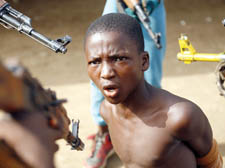|
|
 |
| |

A scene from the brutally powerful Johnny Mad Dog |
Shock portrait of children at war
JOHNNY MAD DOG
Directed by Jean-Stephane Sauvaire
Certificate 18
THE opening scene in this incredible film shows a unit of a rebel army, staffed by children, march into a village and demand payment from the dirt poor villagers. When cash is not forthcoming, they begin to search for children to kidnap.
One is found and ordered to murder his father in front of the rest of the village, as punishment for hiding.
It is hardly a gentle way to start a film, but as we discover soon in Johnny Mad Dog, it is par for the course. What transpires is one of the most effective, moving, shocking and generally disgusting portrayals of war today.
We follow this tiny troupe of wanton killers as they follow their army’s leadership from countryside to city, finding a camaraderie in their gang that makes up for the loss of family, with their general becoming a father figure for these poor souls.
Despite their despicable murdering behaviour, you instantly feel sorry for the child soldiers. We watch them being conned by older soldiers into thinking witchcraft will stop bullets from harming them.
And as you gradually learn their names – No Good Advice, Young Major Butterfly, decked out in fairy wings, and Small Devil – you sense the fear of the situation they find themselves in. Other bizarre characters emerge – one soldier is decked out in a wedding dress, while another wears brightly painted boots and a pair of speedos as he hoiks about a rocket launcher. Apparently these bizarre costumes were encouraged during the Liberian war to give the soldiers a sense of personal identity.
A side-plot then comes to the fore: we meet 13-year-old Laokole who is caring for her disabled father (we learn he had his legs hacked off in an earlier war) and her little brother, Fofo.
Their story runs parallel to that of the vicious child unit, as they try to stay alive and escape the rolling waves of violence engulfing the country.
The power of this film is its no-frills approach, and the haunting fact that this is not fiction: it’s based on the tragedy that for many young people, this was an all too real experience. Filmed on location in Liberia, it is an unnamed country that features, an unnamed war: this again adds to the general sense of tension – it could be relating to the experience of any number of nations.
The political violence that racked many African nations in the latter half of the 20th century has been linked to the fall of empires. In Ruth Furst’s tome, The Man On Horse Back, she argues that elements needed to run an empire left a legacy that has led to dictatorships and violence – a strong military, a strong civil service, and no democratic tradition, or at least not in living memory.
Such a poisonous legacy leads to disasters portrayed in this incredibly moving, edge-of-the seat movie. It is pretty hard to sleep after this film. |
 |
|
 |
| |
|
 |
|

